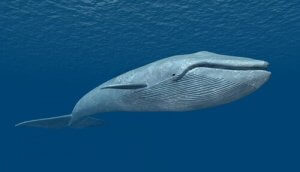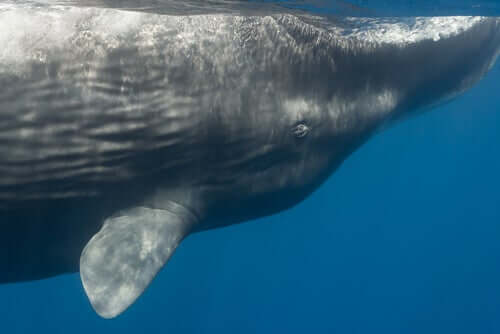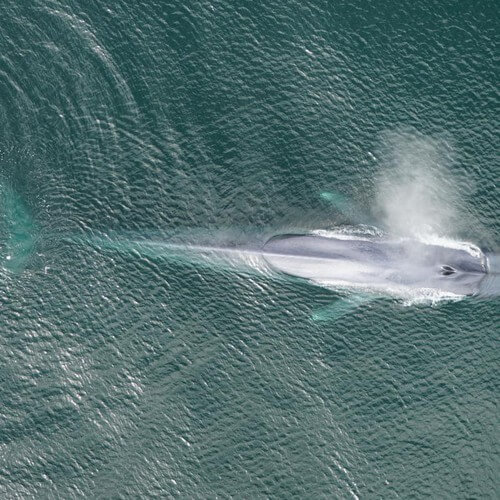The Blue Whale: The Largest Living Animal

The blue whale is the largest animal that has ever lived on our planet. Some scientists say it’s even larger than any of the dinosaurs or any known prehistoric species. Weighing up to 120 tons, these huge aquatic mammals are able to migrate all across the globe. Coming up next, we’ll tell you what we know about the fantastic blue whales.
Characteristics and appearance
The blue whale is a mystical cetacean. This marine mammal, unlike orcas and like sperm whales, has no teeth and is also related to dolphins or belugas. They feed mainly on krill: small crustaceans that live in seas around the world.
They are the largest animals that we are aware of, and they reach an average size of approximately 98 feet long. Estimates say that adults weigh around 100 or 120 tons, although it is known that specimens have come to weigh 170 to 190 tons.
Morphology
Morphology wise, they have a long and slender body. Their name is due to their color, which can be bluish-gray throughout the body and a little lighter-colored throughout the belly area. Its head is so large that it occupies almost a quarter of the total size of its body, although they have a very small dorsal fin in relation to the rest of its body.
They move underwater thanks to their two large side fins and their powerful tail. You can usually spot their dorsal fins coming out of the water while they’re getting some impulse before diving into deep waters.
Behavior
The blue whale is an independent animal that usually lives alone or in pairs. Some studies indicate that whale couples are usually made up of a male and a female and that they can live together for long seasons.
On the other hand, other studies have found that these couples can separate and meet with other whales after some time. In areas where there’s a lot of food, you can see small groups of whales together. However, the whales’ social interactions and behavior will largely depend on the location they’re in.
They usually spend the summer feeding in the polar areas and as winter approaches, they migrate to the equator areas. Whales are migratory animals that travel thousands of miles each year around the globe.
Coming up to breathe
In order to breathe, the blue whale has to come up to the surface. However, when it does, it can produce a spectacular jet of steam that reaches almost 40 feet high. They can remain underwater for about 20 minutes before having to come up again, so it’s relatively easy to observe them and enjoy the amazing show they perform.

Habitat and conservation
A few centuries ago, the blue whale lived in every ocean on the planet. Nevertheless, it should be noted that over the past 100 years its population has declined so much that it can currently only be found in the Atlantic and Pacific Oceans. However, some scientists and observers claim they have recently spotted them in the Indian Ocean.
In addition, because they make such large migrations (from the poles to equator) it’s relatively easy to find whales scattered throughout the oceans. However, indiscriminate whale hunting during the 19th and 20th centuries have dwindled the population so much that it is currently difficult to see them.
Whale scientists estimated that the blue whale population was 300,000 specimens before whale hunting became fashionable. In the face of their impending extinction, desperate measures were taken in the year 1996 when the estimations revealed there were between 5,000 and 12,000 specimens left worldwide.

Experts claim that calculating how many blue whales are alive or if there’s a rise in their numbers is very complicated. Recent studies indicate that Icelandic and Californian blue whale populations may be starting to increase, but this is difficult to prove. Scientists estimate that their current population is only 1% of what it used to be. Massive whale hunting is the main cause of this.
However, the bright side is that the blue whale has no natural predators due to its gigantic size. Nevertheless, humans are the main threat to their survival’s success. Despite whale hunting is illegal, blue whales can occasionally crash into a ship and hurt themselves, sometimes fatally.
Blue Whale threatened
Blue whales are the largest settlers who have lived on our planet. These spectacular cetaceans are endangered, and although their situation is dire, every effort is being made to save them. Apparently, so much work is starting to pay off, but it’s too soon to celebrate yet.
The blue whale is the largest animal that has ever lived on our planet. Some scientists say it’s even larger than any of the dinosaurs or any known prehistoric species. Weighing up to 120 tons, these huge aquatic mammals are able to migrate all across the globe. Coming up next, we’ll tell you what we know about the fantastic blue whales.
Characteristics and appearance
The blue whale is a mystical cetacean. This marine mammal, unlike orcas and like sperm whales, has no teeth and is also related to dolphins or belugas. They feed mainly on krill: small crustaceans that live in seas around the world.
They are the largest animals that we are aware of, and they reach an average size of approximately 98 feet long. Estimates say that adults weigh around 100 or 120 tons, although it is known that specimens have come to weigh 170 to 190 tons.
Morphology
Morphology wise, they have a long and slender body. Their name is due to their color, which can be bluish-gray throughout the body and a little lighter-colored throughout the belly area. Its head is so large that it occupies almost a quarter of the total size of its body, although they have a very small dorsal fin in relation to the rest of its body.
They move underwater thanks to their two large side fins and their powerful tail. You can usually spot their dorsal fins coming out of the water while they’re getting some impulse before diving into deep waters.
Behavior
The blue whale is an independent animal that usually lives alone or in pairs. Some studies indicate that whale couples are usually made up of a male and a female and that they can live together for long seasons.
On the other hand, other studies have found that these couples can separate and meet with other whales after some time. In areas where there’s a lot of food, you can see small groups of whales together. However, the whales’ social interactions and behavior will largely depend on the location they’re in.
They usually spend the summer feeding in the polar areas and as winter approaches, they migrate to the equator areas. Whales are migratory animals that travel thousands of miles each year around the globe.
Coming up to breathe
In order to breathe, the blue whale has to come up to the surface. However, when it does, it can produce a spectacular jet of steam that reaches almost 40 feet high. They can remain underwater for about 20 minutes before having to come up again, so it’s relatively easy to observe them and enjoy the amazing show they perform.

Habitat and conservation
A few centuries ago, the blue whale lived in every ocean on the planet. Nevertheless, it should be noted that over the past 100 years its population has declined so much that it can currently only be found in the Atlantic and Pacific Oceans. However, some scientists and observers claim they have recently spotted them in the Indian Ocean.
In addition, because they make such large migrations (from the poles to equator) it’s relatively easy to find whales scattered throughout the oceans. However, indiscriminate whale hunting during the 19th and 20th centuries have dwindled the population so much that it is currently difficult to see them.
Whale scientists estimated that the blue whale population was 300,000 specimens before whale hunting became fashionable. In the face of their impending extinction, desperate measures were taken in the year 1996 when the estimations revealed there were between 5,000 and 12,000 specimens left worldwide.

Experts claim that calculating how many blue whales are alive or if there’s a rise in their numbers is very complicated. Recent studies indicate that Icelandic and Californian blue whale populations may be starting to increase, but this is difficult to prove. Scientists estimate that their current population is only 1% of what it used to be. Massive whale hunting is the main cause of this.
However, the bright side is that the blue whale has no natural predators due to its gigantic size. Nevertheless, humans are the main threat to their survival’s success. Despite whale hunting is illegal, blue whales can occasionally crash into a ship and hurt themselves, sometimes fatally.
Blue Whale threatened
Blue whales are the largest settlers who have lived on our planet. These spectacular cetaceans are endangered, and although their situation is dire, every effort is being made to save them. Apparently, so much work is starting to pay off, but it’s too soon to celebrate yet.
This text is provided for informational purposes only and does not replace consultation with a professional. If in doubt, consult your specialist.








